[讲义]04-Digital Signals and Signal Processing
- 格式:pdf
- 大小:374.00 KB
- 文档页数:13
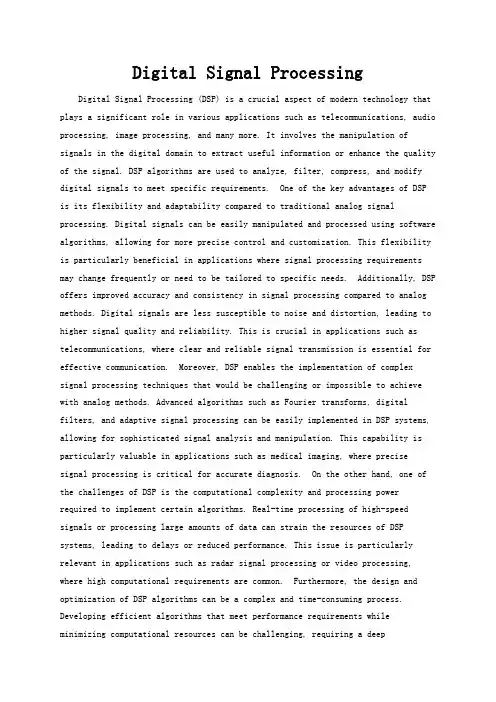
Digital Signal Processing Digital Signal Processing (DSP) is a crucial aspect of modern technology that plays a significant role in various applications such as telecommunications, audio processing, image processing, and many more. It involves the manipulation of signals in the digital domain to extract useful information or enhance the quality of the signal. DSP algorithms are used to analyze, filter, compress, and modify digital signals to meet specific requirements. One of the key advantages of DSP is its flexibility and adaptability compared to traditional analog signal processing. Digital signals can be easily manipulated and processed using software algorithms, allowing for more precise control and customization. This flexibility is particularly beneficial in applications where signal processing requirements may change frequently or need to be tailored to specific needs. Additionally, DSP offers improved accuracy and consistency in signal processing compared to analog methods. Digital signals are less susceptible to noise and distortion, leading to higher signal quality and reliability. This is crucial in applications such as telecommunications, where clear and reliable signal transmission is essential for effective communication. Moreover, DSP enables the implementation of complex signal processing techniques that would be challenging or impossible to achieve with analog methods. Advanced algorithms such as Fourier transforms, digital filters, and adaptive signal processing can be easily implemented in DSP systems, allowing for sophisticated signal analysis and manipulation. This capability is particularly valuable in applications such as medical imaging, where precise signal processing is critical for accurate diagnosis. On the other hand, one of the challenges of DSP is the computational complexity and processing power required to implement certain algorithms. Real-time processing of high-speed signals or processing large amounts of data can strain the resources of DSP systems, leading to delays or reduced performance. This issue is particularly relevant in applications such as radar signal processing or video processing, where high computational requirements are common. Furthermore, the design and optimization of DSP algorithms can be a complex and time-consuming process. Developing efficient algorithms that meet performance requirements while minimizing computational resources can be challenging, requiring a deepunderstanding of signal processing theory and algorithm optimization techniques. Additionally, testing and debugging DSP systems can be difficult due to the abstract nature of digital signals, making it challenging to identify and correct errors in the processing chain. Despite these challenges, the benefits of DSP outweigh the drawbacks in many applications, making it a vital technology in modern signal processing systems. The ability to manipulate signals with precision, flexibility, and reliability opens up a wide range of possibilities for innovation and advancement in various fields. As technology continues to evolve, the role of DSP will only become more critical in shaping the future of signal processing and communication.。
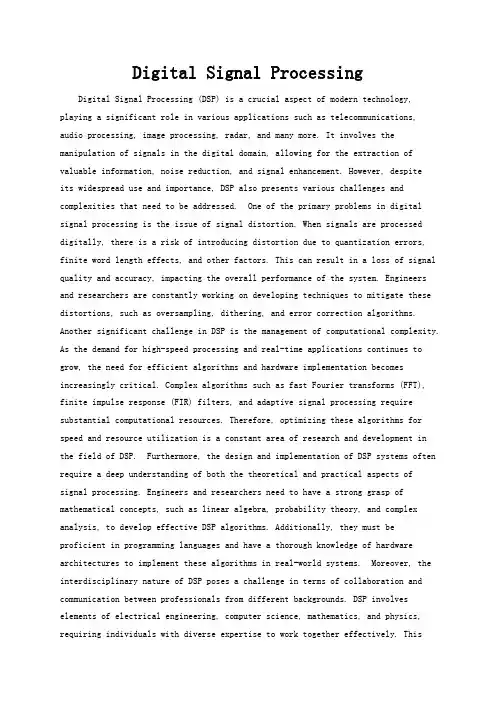
Digital Signal Processing Digital Signal Processing (DSP) is a crucial aspect of modern technology, playing a significant role in various applications such as telecommunications, audio processing, image processing, radar, and many more. It involves the manipulation of signals in the digital domain, allowing for the extraction of valuable information, noise reduction, and signal enhancement. However, despiteits widespread use and importance, DSP also presents various challenges and complexities that need to be addressed. One of the primary problems in digital signal processing is the issue of signal distortion. When signals are processed digitally, there is a risk of introducing distortion due to quantization errors, finite word length effects, and other factors. This can result in a loss of signal quality and accuracy, impacting the overall performance of the system. Engineers and researchers are constantly working on developing techniques to mitigate these distortions, such as oversampling, dithering, and error correction algorithms. Another significant challenge in DSP is the management of computational complexity. As the demand for high-speed processing and real-time applications continues to grow, the need for efficient algorithms and hardware implementation becomes increasingly critical. Complex algorithms such as fast Fourier transforms (FFT), finite impulse response (FIR) filters, and adaptive signal processing require substantial computational resources. Therefore, optimizing these algorithms for speed and resource utilization is a constant area of research and development in the field of DSP. Furthermore, the design and implementation of DSP systems often require a deep understanding of both the theoretical and practical aspects ofsignal processing. Engineers and researchers need to have a strong grasp of mathematical concepts, such as linear algebra, probability theory, and complex analysis, to develop effective DSP algorithms. Additionally, they must beproficient in programming languages and have a thorough knowledge of hardware architectures to implement these algorithms in real-world systems. Moreover, the interdisciplinary nature of DSP poses a challenge in terms of collaboration and communication between professionals from different backgrounds. DSP involves elements of electrical engineering, computer science, mathematics, and physics, requiring individuals with diverse expertise to work together effectively. Thisnecessitates the development of interdisciplinary skills and a collaborative mindset to tackle the complex problems and drive innovation in the field ofdigital signal processing. In addition to technical challenges, ethical considerations also come into play in the realm of digital signal processing. The use of DSP in areas such as surveillance, data analysis, and communication raises concerns about privacy, security, and the potential misuse of technology. Engineers and researchers must be mindful of these ethical implications and work towards the responsible and ethical use of DSP to safeguard the rights and privacy of individuals. In conclusion, digital signal processing is a multifaceted field that presents various challenges, ranging from technical complexities to ethical considerations. Addressing these challenges requires a combination of technical expertise, interdisciplinary collaboration, and ethical awareness. As technology continues to advance, the field of DSP will undoubtedly evolve, bringing forth new challenges and opportunities for innovation. It is essential for professionals in this field to remain adaptable, creative, and ethically conscious as they navigate the complexities of digital signal processing.。
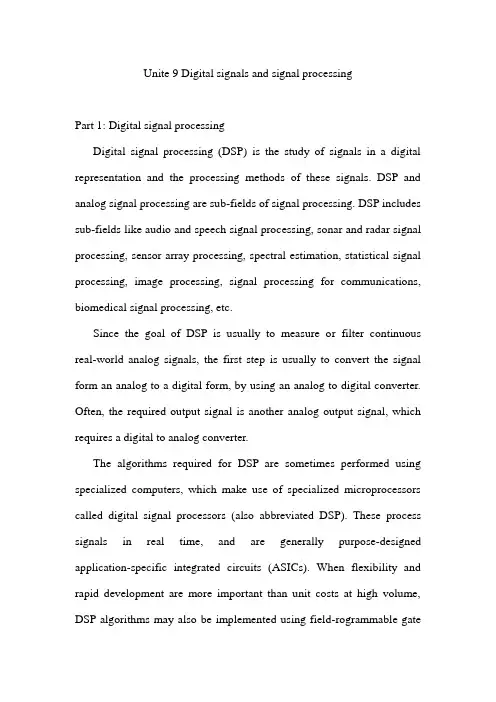
Unite 9 Digital signals and signal processingPart 1: Digital signal processingDigital signal processing (DSP) is the study of signals in a digital representation and the processing methods of these signals. DSP and analog signal processing are sub-fields of signal processing. DSP includes sub-fields like audio and speech signal processing, sonar and radar signal processing, sensor array processing, spectral estimation, statistical signal processing, image processing, signal processing for communications, biomedical signal processing, etc.Since the goal of DSP is usually to measure or filter continuous real-world analog signals, the first step is usually to convert the signal form an analog to a digital form, by using an analog to digital converter. Often, the required output signal is another analog output signal, which requires a digital to analog converter.The algorithms required for DSP are sometimes performed using specialized computers, which make use of specialized microprocessors called digital signal processors (also abbreviated DSP). These process signals in real time, and are generally purpose-designed application-specific integrated circuits (ASICs). When flexibility and rapid development are more important than unit costs at high volume, DSP algorithms may also be implemented using field-rogrammable gatearrays (FPGAs).DSP domainsIn DSP, engineers usually study digital signals in one of the following domains: time domain (one-dimensional signals), spatial domain (multidimensional signals), frequency domain, autocorrelation domain, and wavelet domains. They choose the domain in which to process a signal by making an informed guess (or by trying different possibilities) as to which domain best represents the essential characteristics of the signal. A sequence of samples form a measuring device produces a time or spatial domain representation, whereas a discrete Fourier transform produces the frequency domain information, that is, the frequency spectrum. Autocorrelation is defined as the cross-correlation of the signal with itself over varying intervals of time or space.Signal samplingWith the increasing use of computers the usage and need of digital signal processing has increased. In order to use an analog signal on computer it must be digitized with an analog to digital converter (ADC). Sampling is usually carried out in tow stages, discretization and quantization. In the discretization stage, the space of signals is partitioned into equivalence classes and discretization is carried out by replacing thesignal with representative signal of the corresponding equivalence class. In the quantization stage the representative signal values are approximated by values form a finite set.In order for a sampled analog signal to be exactly reconstructed, the Nyquist-Shannon sampling theorem must be satisfied. This theorem states that the sampling frequency must be greater than twice the bandwidth of the signal. In practice, the sampling frequency is often significantly more than twice the required bandwidth. The most common bandwidth scenarios are: DC~BW (“baseband”); and f BW, a frequency band centered on a carrier frequency (“direct demodulation”).Time and space domainsThe most common processing approach in the time or space domain is enhancement of the input signal through a method called filtering. Filtering generally consists of some transformation of a number of surrounding samples around the current sample of the input or output signal. There are various ways to characterize filters; for example: - A “linear” filter is a linear transformation of input samples; other filters are “non-linear.” Linear filters satisfy the superposition condition, i.e., if an input is a weighted linear combination of different signals, the output is an equally weighted linear combination of the corresponding output signals.- A “causal” filter uses only previous samples of the input or output signals; while a “non-causal” filter uses future input samples. A non-causal filter can usually be changed into a causal filter by adding a delay to it.- A “time-invariant” filter has constant properties over time; other filters such as adaptive filters change in time.- Some filters are “stable”, others are “unstable”. A stable filter produces an output that converges to a constant value with time or remains bounded within a finite interval. An unstable filter produces output which diverges.- A “finite impulse response” (FIR) filter uses only the input signal, while an “infinite impulse response” filter (IIR) uses both the input signal and previous samples of the output signal. FIR filters are always stable, while IIR filters may be unstable.Most filters can be described in Z-domain (a superset of the frequency domain) by their transfer functions. A filter may also be described as a difference equation, a collection of zeroes and poles or, if it is an FIR filter, an impulse response or step response. The output of an FIR filter to any given input may be calculated by convolving the input signal with the impulse response. Filters can also be represented by block diagrams which can then be used to derive a sample processing algorithm to implement the filter using hardware instructions.Frequency domainSignals are converted from time or space domain to the frequency domain usually through the Fourier transform. The Fourier transform converts the signal information to a magnitude and phase component of each frequency. Often the Fourier transform is converted to the power spectrum, which is the magnitude of each frequency component squared.The most common purpose for analysis of signals in the frequency domain is analysis of signal properties. The engineer can study the spectrum to get information of which frequencies are present in the input signal and which are missing.There are some commonly used frequency domain transformations. For example, the cepstrum converts a signal to the frequency domain through Fourier transform, takes the logarithm, and then applies another Fourier transform. This emphasizes the frequency components with smaller magnitude while retaining the order of magnitudes of frequency components.ApplicationsThe main applications of DSP are audio signal processing, audio compression, digital image processing, video compression, speech processing, speech recognition, digital communications, radar, sonar,seismology, and biomedicine. Specific examples are speech compression and transmission in digital mobile phones, room matching equalization of sound in HiFi and sound reinforcement applications, weather forecasting, economic forecasting, seismic data processing, analysis and control of industrial processes, computer-generated animations in movies, medical imaging such as CAT scans and MRI, image manipulation, high fidelity loudspeaker crossovers and equalization, and audio effects for use with electric guitar amplifiers.ImplementationDigital signal processing is often implemented using specialized microprocessors such as the MC560000 and the TMS320. These often process data using fixed-point arithmetic, although some versions are available which use floating point arithmetic and are more powerful. For faster applications FPGAs might be used. Beginning in 2007, multicore implementations of DSPs have started to emerge. For faster applications with vast usage, ASICs might be designed specifically. For slow applications, a traditional slower processor such as microcontroller can cope.Part 2: General concepts of digital signal processingThere have been tremendous demands in the use of digital computersand special-purpose digital circuitry for performing varied signal processing functions that were originally achieved with analog equipment. The continued evolution of inexpensive integrated circuits has led to a variety of microcomputers and minicomputers that can be used for various signal processing functions. It is now possible to build special-purpose digital processors within much smaller size and lower cost constraints of systems previously all analog in nature.We will provide a general discussion of the basic concepts associated with digital signal processing. To do so, it is appropriate to discuss some common terms and assumptions. Wherever possible the definitions and terminology will be established in accordance with the recommendations of the IEEEE Group on Audio and Electroacoustics.An analog signal is a function that is defined over a continuous range of time and in which the amplitude may assume a continuous range of values. Common examples are the sinusoidal function, the step function, the output of a microphone, etc. the term analog apparently originated from the field of analog computation, in which voltages and currents are used to represent physical variables, but it has been extended in usage.Continuous-time signal is a function that is defined over a continuous range of time, but in which the amplitude may either have a continuous ranger of values or a finite number of possible values. In this context, an analog signal could be considered as a special case of continuous-timesignal. In practice, however, the terms analog and continuous-time are interchanged casually in usage and are often used to mean the same thing. Because of the association of the term analog with physical analogies, preference has been established for the term continuous-time. Nevertheless, there will be cases in which the term analog will be used for clarity, particularly where it relates to the term digital.The term quantization describes the process of representing a variable by a set of distinct values. A quantized variable is one that may assume only distinct values.A discrete-time signal is a function that is defined only at a particular set of values of time. This means that the independent variable, time, is quantized. If the amplitude of a discrete-time signal is permitted to assume a continuous range of values, the function is said to be a sampled-data signal. A sampled-data signal could arise from sampling an analog signal at discrete values of time.A digital signal is a function in which both time and amplitude are quantized. A digital signal may always be represented by a sequence of numbers in which each number has a finite number of digits.The terms discrete-time and digital are often interchanged in practice and are often used to mean the same thing. A great deal of the theory underlying discreet-time signals is applicable to purely digital signals, so it is not always necessary to make rigid distinctions. The term。
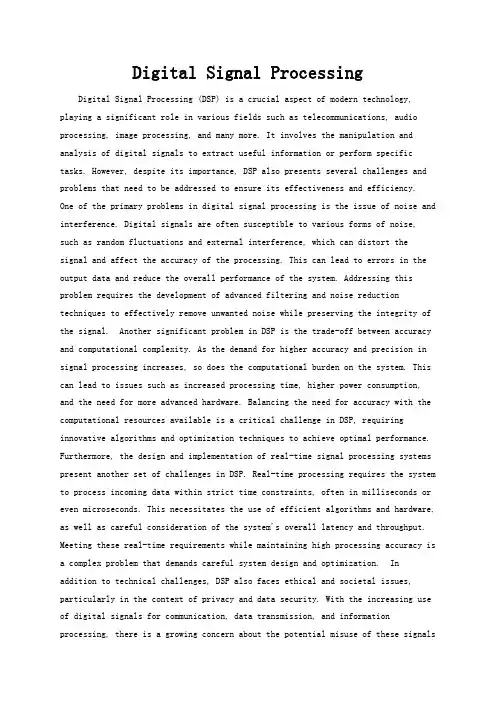
Digital Signal Processing Digital Signal Processing (DSP) is a crucial aspect of modern technology, playing a significant role in various fields such as telecommunications, audio processing, image processing, and many more. It involves the manipulation and analysis of digital signals to extract useful information or perform specific tasks. However, despite its importance, DSP also presents several challenges and problems that need to be addressed to ensure its effectiveness and efficiency. One of the primary problems in digital signal processing is the issue of noise and interference. Digital signals are often susceptible to various forms of noise, such as random fluctuations and external interference, which can distort the signal and affect the accuracy of the processing. This can lead to errors in the output data and reduce the overall performance of the system. Addressing this problem requires the development of advanced filtering and noise reduction techniques to effectively remove unwanted noise while preserving the integrity of the signal. Another significant problem in DSP is the trade-off between accuracy and computational complexity. As the demand for higher accuracy and precision in signal processing increases, so does the computational burden on the system. This can lead to issues such as increased processing time, higher power consumption, and the need for more advanced hardware. Balancing the need for accuracy with the computational resources available is a critical challenge in DSP, requiring innovative algorithms and optimization techniques to achieve optimal performance. Furthermore, the design and implementation of real-time signal processing systems present another set of challenges in DSP. Real-time processing requires the system to process incoming data within strict time constraints, often in milliseconds or even microseconds. This necessitates the use of efficient algorithms and hardware, as well as careful consideration of the system's overall latency and throughput. Meeting these real-time requirements while maintaining high processing accuracy is a complex problem that demands careful system design and optimization. Inaddition to technical challenges, DSP also faces ethical and societal issues, particularly in the context of privacy and data security. With the increasing use of digital signals for communication, data transmission, and information processing, there is a growing concern about the potential misuse of these signalsfor unauthorized surveillance, data breaches, and privacy violations. Ensuring the security and privacy of digital signals is a critical problem that requires the development of robust encryption and authentication mechanisms, as well as the establishment of ethical guidelines for the use of digital signal processing technology. Moreover, the rapid advancement of DSP technology also raises concerns about its potential impact on employment and job displacement. As DSP systems become more sophisticated and capable of performing complex tasks autonomously, there is a risk of job loss for workers whose roles can be automated by these systems. This has significant implications for the workforce and the economy, necessitating proactive measures to retrain and upskill workers, as well as the need for policies to address potential job displacement due to technological advancements in DSP. In conclusion, digital signal processing is a vital and rapidly evolving field with a wide range of technical, ethical, and societal challenges. Addressing these problems requires a multidisciplinary approach, encompassing advanced technical research, ethical considerations, and proactive policy-making. By tackling these challenges, we can ensure the continued advancement and responsible use of digital signal processing technology for the benefit of society.。
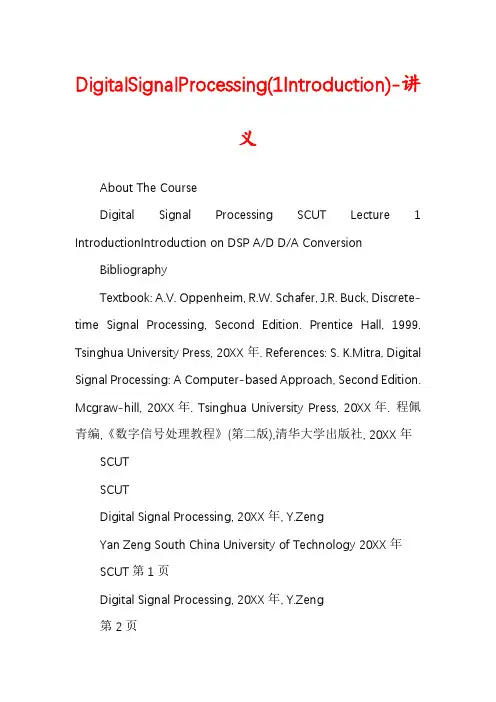
DigitalSignalProcessing(1Introduction)-讲义About The CourseDigital Signal Processing SCUT Lecture 1 IntroductionIntroduction on DSP A/D D/A Conversion BibliographyTextbook: A.V. Oppenheim, R.W. Schafer, J.R. Buck, Discrete-time Signal Processing, Second Edition. Prentice Hall, 1999. Tsinghua University Press, 20XX年. References: S. K.Mitra, Digital Signal Processing: A Computer-based Approach, Second Edition. Mcgraw-hill, 20XX年. Tsinghua University Press, 20XX年. 程佩青编,《数字信号处理教程》(第二版),清华大学出版社, 20XX年SCUTSCUTDigital Signal Processing, 20XX年, Y.ZengYan Zeng South China University of Technology 20XX年SCUT第1页Digital Signal Processing, 20XX年, Y.Zeng第2页About The Course Instructor: Yan Zeng,C Phone: 8711 4480 (H), 189 **** ****C Office: Building#18 (412)C E-Mail: yzeng@, zengyan.gz@C E-Mail for submitting reports: scutoptics@ Grading PolicyCExercises and Reports: 20%CFinal exam: 80% Exercises and Reports: There are proper exercises, homeworks or reports every week, which must be delivered on every Wednesday.Digital Signal Processing, 20XX年, Y.Zeng第3页About The CourseSCUT眼界决定境界,视野决定胸怀,行动决定命运!广泛阅读,善于思考,勤于实践!仰望星空,脚踏实地!SCUTI will give you many careful and trenchant discussion on DSP theories, methods and a wild view to modern science and technoloty. Wish you have a great journey in the course!SCUTSCUTDigital Signal Processing, 20XX年, Y.Zeng第4页Chapter 1 Introduction Background Aim Motivation What is DSP Characteristics of DSP Basic Framework Main Application and Some Examples Sampling and Quantization( A/D D/A Conversion)1.1 BackgroundSCUT建安24年(公元219年)腊月,曹操与华佗。
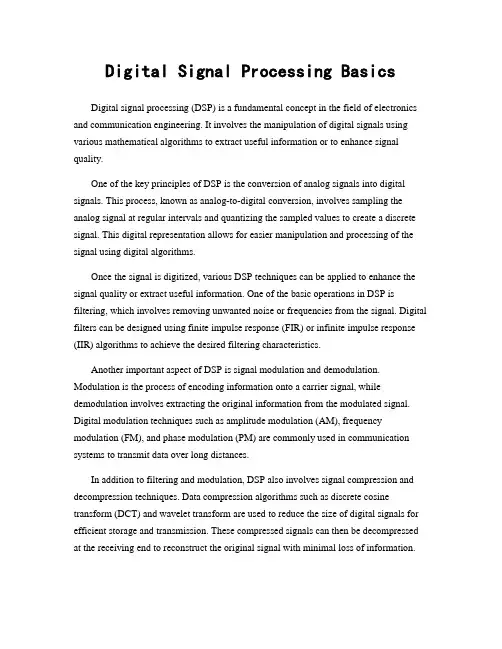
Digital Signal Processing BasicsDigital signal processing (DSP) is a fundamental concept in the field of electronics and communication engineering. It involves the manipulation of digital signals using various mathematical algorithms to extract useful information or to enhance signal quality.One of the key principles of DSP is the conversion of analog signals into digital signals. This process, known as analog-to-digital conversion, involves sampling the analog signal at regular intervals and quantizing the sampled values to create a discrete signal. This digital representation allows for easier manipulation and processing of the signal using digital algorithms.Once the signal is digitized, various DSP techniques can be applied to enhance the signal quality or extract useful information. One of the basic operations in DSP is filtering, which involves removing unwanted noise or frequencies from the signal. Digital filters can be designed using finite impulse response (FIR) or infinite impulse response (IIR) algorithms to achieve the desired filtering characteristics.Another important aspect of DSP is signal modulation and demodulation. Modulation is the process of encoding information onto a carrier signal, while demodulation involves extracting the original information from the modulated signal. Digital modulation techniques such as amplitude modulation (AM), frequency modulation (FM), and phase modulation (PM) are commonly used in communication systems to transmit data over long distances.In addition to filtering and modulation, DSP also involves signal compression and decompression techniques. Data compression algorithms such as discrete cosine transform (DCT) and wavelet transform are used to reduce the size of digital signals for efficient storage and transmission. These compressed signals can then be decompressed at the receiving end to reconstruct the original signal with minimal loss of information.Furthermore, DSP is essential in the implementation of digital audio and image processing systems. Audio signals can be enhanced using techniques such as equalization, noise reduction, and audio effects processing. Image processing algorithms can be used for tasks such as image enhancement, segmentation, object recognition, and pattern recognition.Overall, digital signal processing is a crucial field that enables the manipulation, analysis, and transmission of digital signals in various applications such as telecommunications, audio processing, medical imaging, radar systems, and many more. By understanding the basics of DSP and mastering the fundamental algorithms and techniques, engineers and researchers can develop innovative solutions to address real-world signal processing challenges.。
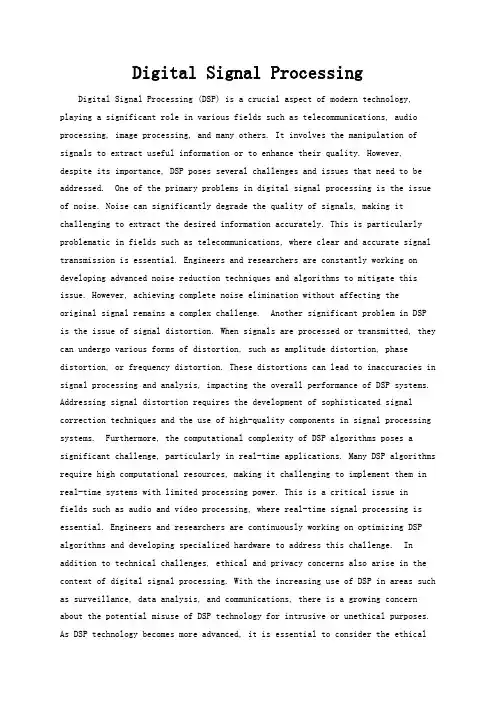
Digital Signal Processing Digital Signal Processing (DSP) is a crucial aspect of modern technology, playing a significant role in various fields such as telecommunications, audio processing, image processing, and many others. It involves the manipulation of signals to extract useful information or to enhance their quality. However, despite its importance, DSP poses several challenges and issues that need to be addressed. One of the primary problems in digital signal processing is the issue of noise. Noise can significantly degrade the quality of signals, making it challenging to extract the desired information accurately. This is particularly problematic in fields such as telecommunications, where clear and accurate signal transmission is essential. Engineers and researchers are constantly working on developing advanced noise reduction techniques and algorithms to mitigate this issue. However, achieving complete noise elimination without affecting theoriginal signal remains a complex challenge. Another significant problem in DSP is the issue of signal distortion. When signals are processed or transmitted, they can undergo various forms of distortion, such as amplitude distortion, phase distortion, or frequency distortion. These distortions can lead to inaccuracies in signal processing and analysis, impacting the overall performance of DSP systems. Addressing signal distortion requires the development of sophisticated signal correction techniques and the use of high-quality components in signal processing systems. Furthermore, the computational complexity of DSP algorithms poses a significant challenge, particularly in real-time applications. Many DSP algorithms require high computational resources, making it challenging to implement them in real-time systems with limited processing power. This is a critical issue infields such as audio and video processing, where real-time signal processing is essential. Engineers and researchers are continuously working on optimizing DSP algorithms and developing specialized hardware to address this challenge. In addition to technical challenges, ethical and privacy concerns also arise in the context of digital signal processing. With the increasing use of DSP in areas such as surveillance, data analysis, and communications, there is a growing concern about the potential misuse of DSP technology for intrusive or unethical purposes. As DSP technology becomes more advanced, it is essential to consider the ethicalimplications and ensure that it is used responsibly and in compliance with privacy regulations. Moreover, the rapid evolution of DSP technology poses a challenge in terms of skill development and training. As DSP techniques and algorithms continue to advance, there is a growing demand for professionals with expertise in this field. However, keeping up with the latest developments in DSP and acquiring the necessary skills can be a daunting task for individuals and organizations. Addressing this challenge requires a concerted effort to provide accessible and comprehensive education and training in digital signal processing. In conclusion, digital signal processing is a fundamental aspect of modern technology, playing a crucial role in various applications. However, it is not without its challenges. From technical issues such as noise and signal distortion to ethical concerns and the need for continuous skill development, there are several aspects that need to be addressed in the context of digital signal processing. By acknowledging these challenges and working towards innovative solutions, we can ensure the continued advancement and responsible use of DSP technology.。
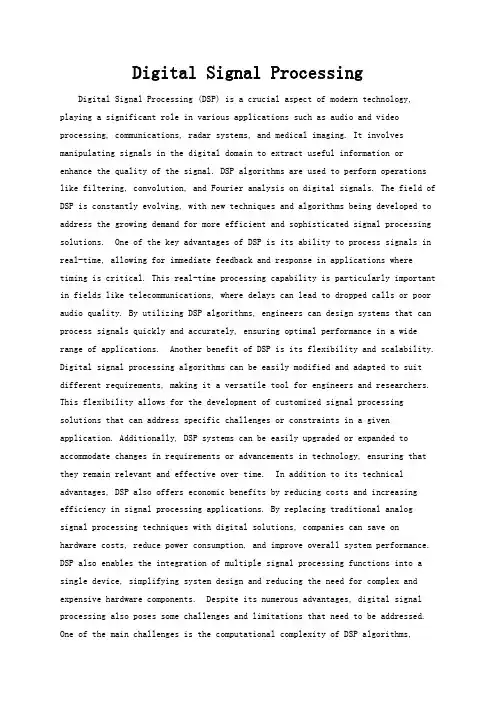
Digital Signal Processing Digital Signal Processing (DSP) is a crucial aspect of modern technology, playing a significant role in various applications such as audio and video processing, communications, radar systems, and medical imaging. It involves manipulating signals in the digital domain to extract useful information or enhance the quality of the signal. DSP algorithms are used to perform operations like filtering, convolution, and Fourier analysis on digital signals. The field of DSP is constantly evolving, with new techniques and algorithms being developed to address the growing demand for more efficient and sophisticated signal processing solutions. One of the key advantages of DSP is its ability to process signals in real-time, allowing for immediate feedback and response in applications where timing is critical. This real-time processing capability is particularly important in fields like telecommunications, where delays can lead to dropped calls or poor audio quality. By utilizing DSP algorithms, engineers can design systems that can process signals quickly and accurately, ensuring optimal performance in a wide range of applications. Another benefit of DSP is its flexibility and scalability. Digital signal processing algorithms can be easily modified and adapted to suit different requirements, making it a versatile tool for engineers and researchers. This flexibility allows for the development of customized signal processing solutions that can address specific challenges or constraints in a given application. Additionally, DSP systems can be easily upgraded or expanded to accommodate changes in requirements or advancements in technology, ensuring that they remain relevant and effective over time. In addition to its technical advantages, DSP also offers economic benefits by reducing costs and increasing efficiency in signal processing applications. By replacing traditional analog signal processing techniques with digital solutions, companies can save on hardware costs, reduce power consumption, and improve overall system performance. DSP also enables the integration of multiple signal processing functions into a single device, simplifying system design and reducing the need for complex and expensive hardware components. Despite its numerous advantages, digital signal processing also poses some challenges and limitations that need to be addressed. One of the main challenges is the computational complexity of DSP algorithms,which can require significant processing power and memory resources to execute efficiently. This complexity can limit the performance of DSP systems in resource-constrained environments or applications where real-time processing is critical. Engineers must carefully optimize their algorithms and hardware implementations to ensure that DSP systems meet the required performance specifications. Another challenge in DSP is the need for accurate and reliable signal processing in noisy or unpredictable environments. Digital signals can be easily corrupted by noise, interference, or distortion, which can affect the quality and accuracy of the processed signal. Engineers must develop robust algorithms and techniques to mitigate these effects and ensure that the processed signal remains clear and accurate in all conditions. This requires a deep understanding of signal processing theory and practical experience in designing and implementing DSP systems. In conclusion, digital signal processing is a powerful and versatile technology that plays a crucial role in a wide range of applications. From telecommunications to medical imaging, DSP algorithms enable engineers to process signals quickly and accurately, leading to improved system performance and efficiency. While DSP offers numerous advantages, including real-time processing, flexibility, and cost savings, it also presents challenges such as computational complexity and signal noise. By addressing these challenges and leveraging the benefits of DSP, engineers can continue to develop innovative solutions that push the boundaries of signal processing technology.。
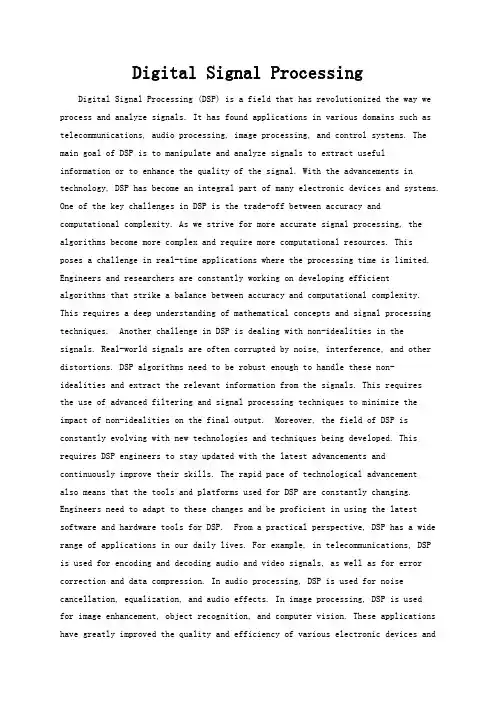
Digital Signal Processing Digital Signal Processing (DSP) is a field that has revolutionized the way we process and analyze signals. It has found applications in various domains such as telecommunications, audio processing, image processing, and control systems. The main goal of DSP is to manipulate and analyze signals to extract usefulinformation or to enhance the quality of the signal. With the advancements in technology, DSP has become an integral part of many electronic devices and systems. One of the key challenges in DSP is the trade-off between accuracy andcomputational complexity. As we strive for more accurate signal processing, the algorithms become more complex and require more computational resources. Thisposes a challenge in real-time applications where the processing time is limited. Engineers and researchers are constantly working on developing efficientalgorithms that strike a balance between accuracy and computational complexity.This requires a deep understanding of mathematical concepts and signal processing techniques. Another challenge in DSP is dealing with non-idealities in the signals. Real-world signals are often corrupted by noise, interference, and other distortions. DSP algorithms need to be robust enough to handle these non-idealities and extract the relevant information from the signals. This requiresthe use of advanced filtering and signal processing techniques to minimize the impact of non-idealities on the final output. Moreover, the field of DSP is constantly evolving with new technologies and techniques being developed. This requires DSP engineers to stay updated with the latest advancements andcontinuously improve their skills. The rapid pace of technological advancementalso means that the tools and platforms used for DSP are constantly changing. Engineers need to adapt to these changes and be proficient in using the latest software and hardware tools for DSP. From a practical perspective, DSP has a wide range of applications in our daily lives. For example, in telecommunications, DSPis used for encoding and decoding audio and video signals, as well as for error correction and data compression. In audio processing, DSP is used for noise cancellation, equalization, and audio effects. In image processing, DSP is usedfor image enhancement, object recognition, and computer vision. These applications have greatly improved the quality and efficiency of various electronic devices andsystems. In conclusion, digital signal processing is a complex and challenging field that requires a deep understanding of mathematical concepts, signal processing techniques, and the latest advancements in technology. Engineers and researchers in this field need to constantly strive for more accurate and efficient algorithms while dealing with non-idealities in the signals. Despite these challenges, the wide range of applications and the impact of DSP on our daily lives make it a fascinating and rewarding field to work in. As technology continues to advance, the field of DSP will continue to evolve, presenting new challenges and opportunities for those involved in the field.。
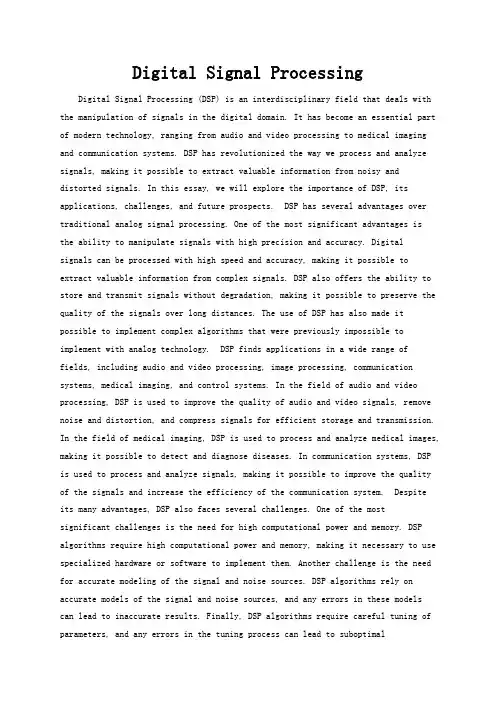
Digital Signal Processing Digital Signal Processing (DSP) is an interdisciplinary field that deals with the manipulation of signals in the digital domain. It has become an essential part of modern technology, ranging from audio and video processing to medical imaging and communication systems. DSP has revolutionized the way we process and analyze signals, making it possible to extract valuable information from noisy anddistorted signals. In this essay, we will explore the importance of DSP, its applications, challenges, and future prospects. DSP has several advantages over traditional analog signal processing. One of the most significant advantages isthe ability to manipulate signals with high precision and accuracy. Digitalsignals can be processed with high speed and accuracy, making it possible toextract valuable information from complex signals. DSP also offers the ability to store and transmit signals without degradation, making it possible to preserve the quality of the signals over long distances. The use of DSP has also made it possible to implement complex algorithms that were previously impossible to implement with analog technology. DSP finds applications in a wide range of fields, including audio and video processing, image processing, communication systems, medical imaging, and control systems. In the field of audio and video processing, DSP is used to improve the quality of audio and video signals, remove noise and distortion, and compress signals for efficient storage and transmission. In the field of medical imaging, DSP is used to process and analyze medical images, making it possible to detect and diagnose diseases. In communication systems, DSPis used to process and analyze signals, making it possible to improve the quality of the signals and increase the efficiency of the communication system. Despiteits many advantages, DSP also faces several challenges. One of the mostsignificant challenges is the need for high computational power and memory. DSP algorithms require high computational power and memory, making it necessary to use specialized hardware or software to implement them. Another challenge is the need for accurate modeling of the signal and noise sources. DSP algorithms rely on accurate models of the signal and noise sources, and any errors in these modelscan lead to inaccurate results. Finally, DSP algorithms require careful tuning of parameters, and any errors in the tuning process can lead to suboptimalperformance. The future prospects of DSP are promising, with new applications emerging in fields such as artificial intelligence, robotics, and autonomous systems. DSP algorithms are being used to process and analyze data from sensors and cameras in autonomous systems, making it possible to detect and avoid obstacles, track objects, and navigate in complex environments. DSP algorithms are also being used in artificial intelligence and machine learning applications, making it possible to process and analyze large amounts of data and extract valuable information. In conclusion, DSP is an essential field that has revolutionized the way we process and analyze signals. It has several advantages over traditional analog signal processing, including high precision and accuracy, the ability to store and transmit signals without degradation, and the ability to implement complex algorithms. DSP finds applications in a wide range of fields, including audio and video processing, image processing, communication systems, medical imaging, and control systems. Despite its many advantages, DSP also faces several challenges, including the need for high computational power and memory, accurate modeling of the signal and noise sources, and careful tuning of parameters. The future prospects of DSP are promising, with new applications emerging in fields such as artificial intelligence, robotics, and autonomous systems.。
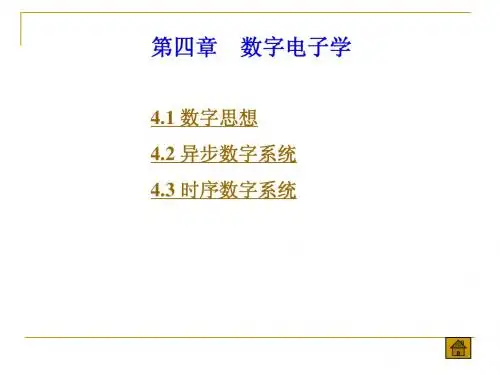
Digital Signal Processing Digital Signal Processing (DSP) is a field of study that has gainedsignificant importance in recent years. It is a technique used to manipulate and analyze digital signals to extract useful information. DSP is used in a wide range of applications such as audio and image processing, speech recognition, radar, and control systems. In this article, we will explore the basics of DSP, its applications, and its impact on our lives.The first step in understanding DSP is to understand what a signal is. A signal is a physical quantity that varies over time or space. For example, sound waves, images, and temperature are all signals. Signals can be classified into two types: analog and digital. Analog signals are continuous in time and can take on any value within a certain range. Digital signals, on the other hand, are discrete in time and can only take on a finite number of values.DSP is the process of manipulating digital signals to extract useful information. This is done using mathematical algorithms and techniques. The most common technique used in DSP is the Fourier transform, which is used to convert a signal from the time domain to the frequency domain. The frequency domain representation of a signal can provide valuable information about its characteristics, such as its frequency components and their amplitudes.One of the most common applications of DSP is in audio processing. DSP is used to enhance and manipulate audio signals in a variety of ways. For example, DSP can be used to remove noise from an audio signal, to equalize the frequency response of a speaker system, or to create special effects such as reverb or delay. DSP is also used in speech recognition systems, where it is used to extract features from speech signals that can be used to identify words and phrases.Another important application of DSP is in image processing. DSP is used to manipulate digital images in a variety of ways, such as enhancing contrast, removing noise, and sharpening edges. DSP is also used in video compression, where it is used to reduce the size of video files without sacrificing quality. DSP is also used in medical imaging, where it is used to enhance images of the human body for diagnosis and treatment.DSP is also used in control systems, where it is used to manipulate signals to control the behavior of a system. For example, DSP can be used to control the speed of a motor, the temperature of a room, or the position of a robotic arm. DSP is also used in radar and sonar systems, where it is used to analyze signals to detect and locate objects.In conclusion, DSP is a field of study that has had a significant impact on our lives. It is used in a wide range of applications such as audio and image processing, speech recognition, radar, and control systems. DSP is a powerful tool that allows us to manipulate and analyze digital signals to extract useful information. As technology continues to advance, the importance of DSP will only continue to grow.。
Digital Signal Processing Digital Signal Processing (DSP) is a field that plays a crucial role invarious aspects of our lives, from communication systems to audio and image processing. It involves the manipulation and analysis of digital signals toextract useful information or enhance the quality of the signals. In this response, I will discuss the importance of DSP from multiple perspectives, including its impact on communication, audio and image processing, and biomedical applications. From a communication perspective, DSP has revolutionized the way we transmit and receive information. It allows for efficient encoding and decoding of signals, enabling high-quality audio and video streaming, as well as reliable data transmission. With the advancements in DSP algorithms, we can now achieve higher data rates and lower error rates in communication systems. This has led to the widespread adoption of technologies such as 4G and 5G networks, which rely heavily on DSP techniques to ensure seamless connectivity and faster data transfer. Inthe realm of audio and image processing, DSP has opened up new possibilities for enhancing the quality of multimedia content. Through techniques like noise reduction, equalization, and compression, we can improve the clarity and fidelity of audio signals. DSP algorithms also enable us to manipulate and modify images, allowing for tasks such as image enhancement, object recognition, and even deep learning-based image analysis. These advancements have greatly impacted industries such as entertainment, surveillance, and medical imaging. Speaking of medical imaging, DSP has played a pivotal role in this field as well. Techniques like image reconstruction, filtering, and segmentation have significantly improved the accuracy and efficiency of medical imaging modalities such as MRI, CT, and ultrasound. By applying DSP algorithms, medical professionals can obtain clearer and more detailed images, aiding in the diagnosis and treatment of various conditions. Moreover, DSP has also found applications in biomedical signal processing, enabling the analysis of signals such as electrocardiograms (ECG) and electroencephalograms (EEG) to monitor and diagnose cardiac and neurological disorders. Another perspective to consider is the impact of DSP on everyday consumer devices. From smartphones to smart speakers, DSP algorithms are at the core of these devices, enabling functionalities like voice recognition, noisecancellation, and audio enhancement. These algorithms not only improve the user experience but also optimize the performance of the devices. For instance, noise cancellation algorithms in headphones eliminate background noise, allowing users to enjoy their audio content without distractions. Similarly, voice recognition algorithms in virtual assistants enable seamless interaction and control of devices through voice commands. In conclusion, Digital Signal Processing is a field that has transformed various aspects of our lives. From its impact on communication systems, audio and image processing, biomedical applications, to everyday consumer devices, DSP has revolutionized the way we transmit and process digital signals. Its advancements have led to faster and more reliable communication, enhanced audio and image quality, improved medical imaging, and optimized consumer devices. As technology continues to evolve, the importance of DSP will only grow, opening up new possibilities and applications in the digital world.。
Digital Signal Processing Digital Signal Processing (DSP) is a crucial aspect of modern technology, playing a significant role in various fields such as telecommunications, audio processing, image processing, and control systems. It involves the manipulation of signals in the digital domain, enabling the extraction of useful information and the enhancement of signal quality. However, like any other technology, DSP is not without its challenges and limitations. In this response, I will explore the problems associated with digital signal processing from various perspectives, including technical, ethical, and societal considerations. From a technical standpoint, one of the primary challenges in digital signal processing is theissue of signal distortion. When signals are digitized, there is a potential for distortion to occur due to quantization errors, sampling rate limitations, and the presence of noise. These distortions can significantly impact the accuracy and reliability of the processed signals, leading to degraded performance in applications such as audio and video processing. Engineers and researchers are constantly striving to develop advanced signal processing algorithms andtechniques to mitigate these distortions and improve the overall quality ofdigital signals. Another technical problem in digital signal processing is the computational complexity of signal processing algorithms. As the demand for real-time processing and high-speed data analysis continues to grow, there is a needfor efficient algorithms that can handle large volumes of data without consuming excessive computational resources. This requires a delicate balance between algorithm complexity and computational efficiency, posing a significant challenge for DSP engineers. Moreover, the rapid evolution of hardware technologies further complicates this issue, as DSP algorithms must be optimized for differentplatforms and architectures. In addition to technical challenges, digital signal processing also raises ethical considerations related to privacy and data security. With the increasing use of DSP in applications such as surveillance, biometric identification, and data analysis, there is a growing concern about the potential misuse of processed signals for unauthorized surveillance or data exploitation. As DSP technologies continue to advance, it is crucial for developers and policymakers to address these ethical concerns and establish regulations to ensurethe responsible and ethical use of digital signal processing techniques. Furthermore, the widespread adoption of digital signal processing in various industries has significant societal implications, particularly in terms of accessibility and inclusivity. While DSP has enabled remarkable advancements in areas such as healthcare diagnostics, communication systems, and assistive technologies, there is a risk of creating a digital divide where certain populations may be excluded from benefiting from these technological advancements due to factors such as economic disparities or limited access to technology. It is essential for stakeholders in the DSP community to consider these societal implications and work towards promoting equitable access to digital signal processing technologies for all individuals. In conclusion, digital signal processing is a powerful and versatile technology that has revolutionized numerous industries and applications. However, it is not without its challenges and considerations, spanning technical, ethical, and societal dimensions. Addressing the technical complexities of signal distortion and computational efficiency, as well as the ethical and societal implications of DSP, requires a concerted effort from engineers, policymakers, and stakeholders to ensure that digital signal processing continues to advance in a responsible and inclusive manner. By acknowledging and addressing these challenges, the potential of digital signal processing to positively impact society can be maximized while mitigatingpotential risks and drawbacks.。
Digital Signal Processing Digital Signal Processing (DSP) is a crucial aspect of modern technology, playing a significant role in various fields such as telecommunications, audio processing, image processing, and control systems. It involves the manipulation of signals to extract useful information or to enhance their quality. However, likeany other technology, DSP comes with its own set of challenges and issues thatneed to be addressed. One of the primary problems in digital signal processing is the issue of noise. Noise can significantly degrade the quality of a signal,making it difficult to extract the desired information. This is particularly problematic in applications such as audio and image processing, where the presence of noise can lead to distorted or unclear output. Engineers and researchers are constantly working on developing algorithms and techniques to mitigate the impactof noise in digital signals, but it remains a persistent challenge. Another issuein DSP is the trade-off between accuracy and computational complexity. In manyreal-world applications, there is a need to process signals in real-time, which requires algorithms to be efficient and computationally lightweight. However, achieving high accuracy in signal processing often requires complex algorithmsthat can be computationally intensive. Balancing these competing demands is a significant challenge in the field of DSP, requiring careful consideration of the specific requirements of each application. Furthermore, the rapid advancement of technology poses a challenge for DSP engineers. As new hardware and software platforms emerge, DSP algorithms and techniques need to be adapted and optimizedto work efficiently on these new platforms. This requires constant learning and adaptation, as well as a deep understanding of the underlying principles of signal processing. Keeping up with these advancements can be a daunting task, but it is essential for ensuring that DSP continues to meet the demands of modern technology. In addition to technical challenges, there are also ethical considerations in DSP that need to be addressed. For example, the use of DSP in surveillance and monitoring systems raises concerns about privacy and data security. As DSP technology becomes more pervasive, it is important for engineers and researchersto consider the ethical implications of their work and to ensure that thetechnology is used in a responsible and ethical manner. Despite these challenges,digital signal processing continues to be a vibrant and exciting field, with new advancements and breakthroughs occurring regularly. The ongoing research and development in DSP are driving innovation in a wide range of applications, from medical imaging to wireless communications. By addressing the technical, ethical, and practical challenges of DSP, engineers and researchers can continue to push the boundaries of what is possible with digital signal processing, ultimately improving the quality of life for people around the world.。
Digital Signal Processing **Embarking on a Journey into the Realm of Digital Signal Processing**Digital Signal Processing (DSP) invites us to explore a captivating world where signals, once confined to the analog domain, transcend into the digital realm. This transformative process unlocks a treasure trove of opportunities, empowering us to manipulate, analyze, and interpret signals with unprecedented precision and efficiency. **Unveiling the Essence of Digital Signal Processing** DSP stands as a cornerstone of modern engineering, medicine, and scientific discovery. Its pervasive influence extends to a kaleidoscope of applications, including image and video processing, radar and sonar systems, telecommunications, and medical diagnostics. At its core, DSP involves converting continuous-time analog signals into discrete-time digital signals, paving the way for sophisticated processing algorithms. **The Allure of Digital** The transition to digital signals brings forth a symphony of advantages. Digital signals are immune to the vagaries of noise and distortion that plague their analog counterparts. They can be stored, transmitted, and processed with remarkable ease, offering resilience andreliability in the face of diverse challenges. Furthermore, digital signals lend themselves seamlessly to manipulation and analysis using powerful computational tools. **A Bridge between Theory and Application** DSP strikes a harmonious balance between theoretical foundations and practical applications. It draws upon a wealth of mathematical concepts, including Fourier analysis, linear algebra, and probability theory, to establish a rigorous framework for understanding signal processing techniques. Simultaneously, DSP finds tangible expression in countless real-world applications, ranging from noise cancellation in headphones to the detection of anomalies in medical scans. **A Continuum of Perspectives** DSP embraces a multifaceted tapestry of perspectives. From the vantage point of electrical engineers, DSP empowers them to design and implement sophisticated signal processing systems. Computer scientists leverage DSP techniques to develop efficient algorithms for data analysis and compression. Mathematicians findfertile ground in DSP for exploring theoretical foundations and developing new signal processing paradigms. **A Catalyst for Innovation** DSP serves as a catalyst for innovation, inspiring breakthroughs in a myriad of fields. It hasrevolutionized the way we communicate, enabling high-fidelity audio and video transmission across vast distances. In medicine, DSP techniques facilitate the development of advanced imaging modalities, such as MRI and ultrasound, providing invaluable insights into human anatomy and physiology. Harnessing the transformative power of DSP, we embark on an exhilarating journey of exploration and discovery. It is a realm where signals dance in harmony with computation, unlocking a symphony of possibilities that shape our world and illuminate the path to the future. As we delve deeper into the intricacies of DSP, may we be guided by curiosity, inspired by innovation, and united by a shared passion for advancing the frontiers of knowledge.。
Digital Signal Processing Digital Signal Processing (DSP) is a crucial aspect of modern technology, impacting various fields such as telecommunications, audio processing, image processing, and more. The significance of DSP lies in its ability to manipulate and analyze digital signals to extract meaningful information, enhance quality, and enable efficient transmission and storage. With the rapid advancement of technology, the demand for innovative DSP techniques continues to grow, presenting both opportunities and challenges in diverse applications. From a technical perspective, DSP involves the use of mathematical algorithms to modify or improve digital signals. This can include tasks such as filtering, noise reduction, compression, and modulation, among others. The implementation of DSP algorithms often requires a deep understanding of signal processing theory, as well as proficiency in programming languages such as MATLAB, Python, or C/C . Engineers and researchers working in this field are constantly exploring new algorithms and techniques to address emerging challenges and improve the performance of digital systems. In the realm of telecommunications, DSP plays a pivotal role in the transmission and reception of digital data. Through techniques such as modulation, demodulation, and error correction coding, DSP enables reliable communication over various channels, including wireless, optical, and satellite communication. Moreover, with the advent of 5G technology and the Internet of Things (IoT), the demand for efficient and high-speed DSP algorithms has surged, driving the needfor continuous innovation in this domain. In the realm of audio and speech processing, DSP algorithms are utilized for tasks such as audio enhancement, speech recognition, and synthesis. These applications have revolutionized the way we interact with technology, enabling voice-controlled assistants, noise-cancelling headphones, and high-fidelity audio reproduction systems. The emotional impact of these advancements is profound, as they have enriched the quality of human communication and entertainment, bringing about a sense of convenience and immersion in our daily lives. In the field of medical imaging, DSP plays acritical role in techniques such as MRI (Magnetic Resonance Imaging) and CT (Computed Tomography) scans. By processing and analyzing the digital signals obtained from medical imaging devices, DSP algorithms contribute to accuratediagnosis and treatment planning, ultimately impacting patient outcomes. The intersection of DSP and healthcare embodies a deeply human aspect, as the advancements in this field directly contribute to the well-being and longevity of individuals around the world. Despite its numerous benefits, DSP also presents challenges, particularly in the realm of real-time processing and resource constraints. In applications where immediate response is crucial, such as radar systems or autonomous vehicles, optimizing DSP algorithms for low latency and efficient resource utilization is a significant hurdle. Moreover, the increasing complexity of digital systems demands continuous research and development to ensure compatibility, security, and reliability. In conclusion, digital signal processing is a multifaceted field with far-reaching implications for technology, communication, healthcare, and beyond. Its technical intricacies are matched only by its profound impact on human experiences, from enabling seamless communication to advancing medical diagnostics. As the digital landscape continues to evolve, the role of DSP in shaping the future of technology and society remains indispensable, calling for ongoing innovation and collaboration across disciplines.。
Technical EnglishFor Information and Communication EngineeringUnit 4Digital Signals and Signal ProcessingPart IDigital Signal ProcessingNew Wordssub-field 分领域,子领域 subsensor array 传感器阵列 algorithm 算法 purpose-designed 针对目的设计的 purposeintegrated circuits 集成电路 wavelet 小波 informed 有知识的,有见闻的 cross-correlation 互相关 crossdiscretization 离散化 partition 分割,分区 sonar 声呐 biomedical 生物特征的 abbreviate 缩写,缩略 application-specific 面向应用的 applicationautocorrelation 自相关 baseband 基带 spatial domain 空间域 interval 间隔 quantization 量化 finite set 有限的集3New Wordstheorem 定理 carrier 载波 demodulation 解调 filtering 滤波 characterize 描绘,刻画性质 causal 因果关系的 diverge 发散 transfer functions 传递函数 derive 推导 cepstrum 倒谱 scenario情节,方案 scenario情节,方案 ingredient 成分,因素 enhancement 增强 weighted 加权的 superposition 叠加 converge 收敛 bounded 有界的 block diagram 方框图 magnitude 大小 logarithm 对数4New WordsFIR (finite impulse response filter) 有限冲击响应滤波器 field-programmable gate array field(FPGA) 现场可编程门阵列 seismology 地震学 hifi (high fidelity) 高保真(音乐) animation 动画 floating point 浮点 magnetic resonance imaging (MRI) 磁共振成像 IIR (infinite impulse response filter) 无限冲击响应滤波器 computer aided tomography (CAT) 计算机断层扫描 equalization 均衡 reinforcement 加强 loudspeaker 扬声器 arithmetic 算术 fixed-point arithmetic fixed定点运算,整数运算51Digital signal processing (DSP) is the study of signals in a digital representation and the processing methods of these signals. DSP and analog signal processing are sub-fields of subsignal processing. DSP includes sub-fields like audio and subspeech signal processing, sonar and radar signal processing, sensor array processing, spectral estimation, statistical signal processing, image processing, signal processing for communications, biomedical signal processing, etc. processing, 音频及语音信号处理、声纳和雷达信号处理、 传感器阵列处理、谱估计、统计信号处理、图 像处理、通信信号处理、生物医学信号处理2Since the goal of DSP is usually to measure or filter continuous real-world analog signals, the first step is usually to convert realsignals, the signal from an analog to a digital form, by using an analog to digital converter. Often, the required output signal is another analog output signal, which requires a digital to analog converter. 数字信号处理的目标通常是 测量连续的真实世界的模拟 信号或对其滤波6 73The algorithms required for DSP are sometimes performed using specialized computers, which make use of specialized microprocessors called digital signal processors (also abbreviated DSP). These process signals in real time, and are generally purpose-designed application-specific integrated purposeapplicationcircuits (ASICs).1 这些(数字信号处理器)实时处理 信号,通常是针对具体目的而设计 的专用集成电路(ASIC)。
的专用集成电路(ASIC)。
83When flexibility and rapid development are more important than unit costs at high volume, DSP algorithms may also be implemented using field-programmable gate arrays (FPGAs).2 field-4 DSP domainsIn DSP, engineers usually study digital signals in one of the following domains: time domain (one-dimensional signals), (onespatial domain (multidimensional signals), frequency domain, autocorrelation domain, and wavelet domains. They choose the domain in which to process a signal by making an 当灵活性和快速开发比大批量生产的 成本更重要时,DSP算法也可以用现 成本更重要时,DSP算法也可以用现 场可编程门阵列来实现。
informed guess (or by trying different possibilities) as to which which domain best represents the essential characteristics of the signal.3 他们按某些依据来猜测(或试验不同的可能 性)那一个域能够最好地表示信号的本质特 性来选择在其中进行信号处理的域。
104A sequence of samples from a measuring device produces a time or spatial domain representation, whereas a discrete Fourier transform produces the frequency domain information, that is, the frequency spectrum.4 Autocorrelation is defined as the cross-correlation of the signal with itself over crossvarying intervals of time or space. 从测量设备得到的样本序列产生(信号的) 时域或空域表示,而离散Fourier变换则产 时域或空域表示,而离散Fourier变换则产 生频域表示即频谱。
1195 Signal samplingWith the increasing use of computers the usage and need of digital signal processing has increased. In order to use an analog signal on a computer it must be digitized with an analog to digital converter (ADC). Sampling is usually carried out in two stages, discretization and quantization. quantization.5In the discretization stage, the space of signals is partitioned into equivalence classes and discretization is carried out by replacing the signal with representative signal of the corresponding equivalence class.5 In the quantization stage the representative signal values are approximated by values from a finite set. set. 在离散化阶段,信号空间被分割为 相等的区间,用相应区间的代表性 信号值代替信号本身。